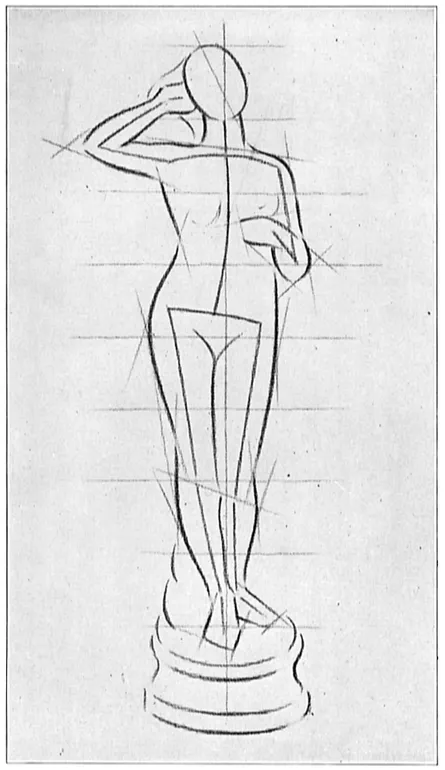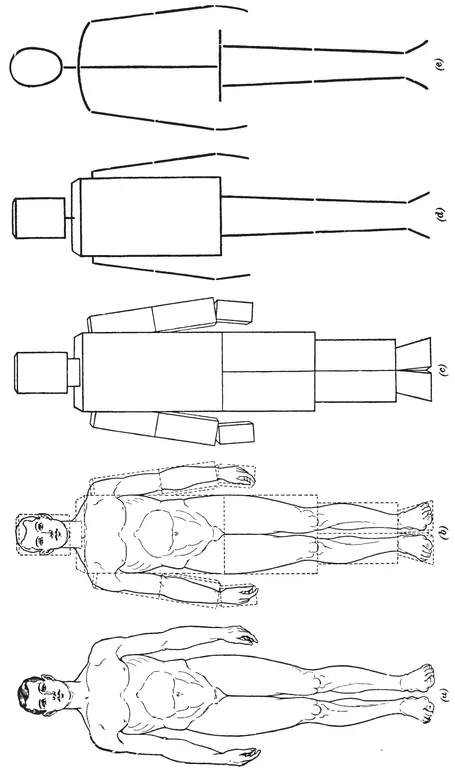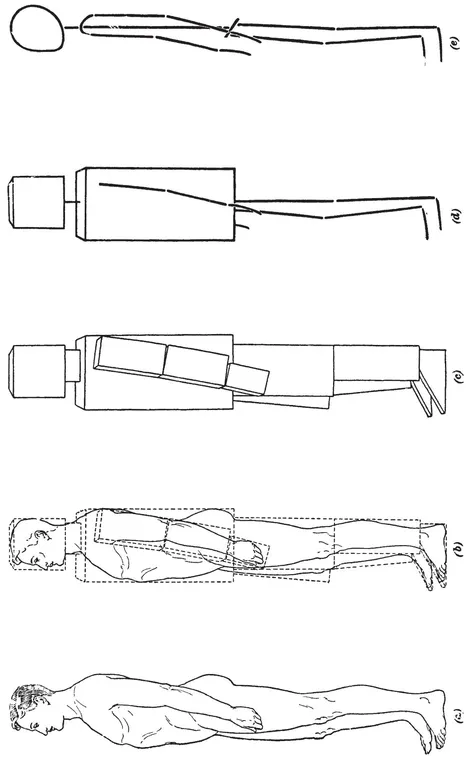
eBook - ePub
Life Drawing
A Complete Course
E. L. Koller
This is a test
Buch teilen
- 224 Seiten
- English
- ePUB (handyfreundlich)
- Über iOS und Android verfügbar
eBook - ePub
Life Drawing
A Complete Course
E. L. Koller
Angaben zum Buch
Buchvorschau
Inhaltsverzeichnis
Quellenangaben
Über dieses Buch
The human figure, with its myriad curves and contours, can be challenging for anyone to draw. In this invaluable reference, well-known art instructor and author E. L. Koller simplifies the process, making it easy for artists to learn new methods of rendering the figure—in action and repose—with accuracy and style.
Using figure-drawing exercises, numerous photos, and illustrations, Koller reduces the task at hand into manageable steps for intermediate and advanced artists. Beginning with drawing basics, this step-by-step guide explores the structure of the human figure and the comparative proportions of child and adult figures, showing how to depict individual parts of the head and body, facial expressions, and gestures. It also shows the merits of sketching from memory; drawing from casts, photographs, and living models; and sketching both undraped and costumed figures. Once the still figure is mastered, the artist can explore the more challenging action poses, including walking, running, and catching. Filled with guidance and insight on the human form, Life Drawing is an essential addition to every artist's reference shelf.
Using figure-drawing exercises, numerous photos, and illustrations, Koller reduces the task at hand into manageable steps for intermediate and advanced artists. Beginning with drawing basics, this step-by-step guide explores the structure of the human figure and the comparative proportions of child and adult figures, showing how to depict individual parts of the head and body, facial expressions, and gestures. It also shows the merits of sketching from memory; drawing from casts, photographs, and living models; and sketching both undraped and costumed figures. Once the still figure is mastered, the artist can explore the more challenging action poses, including walking, running, and catching. Filled with guidance and insight on the human form, Life Drawing is an essential addition to every artist's reference shelf.
Häufig gestellte Fragen
Wie kann ich mein Abo kündigen?
Gehe einfach zum Kontobereich in den Einstellungen und klicke auf „Abo kündigen“ – ganz einfach. Nachdem du gekündigt hast, bleibt deine Mitgliedschaft für den verbleibenden Abozeitraum, den du bereits bezahlt hast, aktiv. Mehr Informationen hier.
(Wie) Kann ich Bücher herunterladen?
Derzeit stehen all unsere auf Mobilgeräte reagierenden ePub-Bücher zum Download über die App zur Verfügung. Die meisten unserer PDFs stehen ebenfalls zum Download bereit; wir arbeiten daran, auch die übrigen PDFs zum Download anzubieten, bei denen dies aktuell noch nicht möglich ist. Weitere Informationen hier.
Welcher Unterschied besteht bei den Preisen zwischen den Aboplänen?
Mit beiden Aboplänen erhältst du vollen Zugang zur Bibliothek und allen Funktionen von Perlego. Die einzigen Unterschiede bestehen im Preis und dem Abozeitraum: Mit dem Jahresabo sparst du auf 12 Monate gerechnet im Vergleich zum Monatsabo rund 30 %.
Was ist Perlego?
Wir sind ein Online-Abodienst für Lehrbücher, bei dem du für weniger als den Preis eines einzelnen Buches pro Monat Zugang zu einer ganzen Online-Bibliothek erhältst. Mit über 1 Million Büchern zu über 1.000 verschiedenen Themen haben wir bestimmt alles, was du brauchst! Weitere Informationen hier.
Unterstützt Perlego Text-zu-Sprache?
Achte auf das Symbol zum Vorlesen in deinem nächsten Buch, um zu sehen, ob du es dir auch anhören kannst. Bei diesem Tool wird dir Text laut vorgelesen, wobei der Text beim Vorlesen auch grafisch hervorgehoben wird. Du kannst das Vorlesen jederzeit anhalten, beschleunigen und verlangsamen. Weitere Informationen hier.
Ist Life Drawing als Online-PDF/ePub verfügbar?
Ja, du hast Zugang zu Life Drawing von E. L. Koller im PDF- und/oder ePub-Format sowie zu anderen beliebten Büchern aus Art & Art Techniques. Aus unserem Katalog stehen dir über 1 Million Bücher zur Verfügung.
Information
Thema
ArtThema
Art TechniquesTHE HUMAN FIGURE

Method of Blocking in, and Proportioning, the Idealized Classic Figure Eight Heads High. The Living Model of the Female Figure is Considered as Only Seven Heads High.
PLACE OF HUMAN FIGURES IN ILLUSTRATING
1. Four Stages in Learning to Draw.—The use of the human figure usually occupies a prominent part in the composition and drawing of pictorial and decorative work. But the human figure is extremely difficult to draw, being composed of so many subtle curves and contours, and such delicate gradations of light and shade in its modeling, that, before these can be drawn and rendered properly, training must be had in drawing more simple forms. For that reason training has been given in line drawing and eye measurement, in model drawing in outline, and in drawing from inanimate models to portray light, shade, and shadow, this preliminary training serving as a series of graded steps leading up to the drawing of the human figure. The next natural and logical step is to draw the human figure, which may be considered the fourth stage in learning to draw.
2. Proper Foundation for Figure Drawing.—Before one can draw the human figure he must be thoroughly familiar with the proportions, measurements, and contours of the human figure as a whole, and of each of its individual parts. To give such a familiarity is the purpose of this subject, which may be considered as a sort of reference book. The information given here must be thoroughly understood, and practice secured in actually sketching such proportions, before the practical work of drawing human figures in various postures and actions can be taken up. In the following subjects the training in figure drawing is extended to include drawing the figure in repose and in action.
Owing to the demand, by a certain class of art students, for a short-cut method of drawing the human figure, unprincipled persons posing as instructors have denied the necessity of a well-laid foundation for drawing the human figure. Their so-called short cuts for teaching the drawing of this, the most complicated of all subjects, however, do not train one to do original work in actually drawing from the living model. They teach only facility in copying the work of others, an accomplishment that is of no practical value to the prospective illustrator.
3. Foundation for Caricaturing and Cartooning.—A careful systematic study of the human figure is absolutely necessary for any one who desires to draw caricatures and cartoons. Many persons, because of the attraction of the pictures in the comic sections of newspapers and in humorous weekly and monthly magazines, acquire a strong desire to do work of this kind. They, therefore, often study the work of their favorite cartoonists thinking that when able to copy this work satisfactorily their training is done. These persons confuse the ability to copy with the ability to originate.
It is impossible to compose and draw cartoons, caricatures, or original pictures of any kind, unless one has had a thorough graded training in drawing, and no one can draw the human figure without a full knowledge of the rules governing its proportions, etc. Caricatures are but drawings of a face or figure with its features exaggerated and cannot be drawn, except from a copy, until the ability to draw the face or figure in its normal proportions has been obtained. This ability is acquired only by a systematic study of figure drawing, facial expression, etc., such as will be given in this and following Sections.
The student is strongly advised against the practice of copying caricatures and cartoons made by professional artists, or making comic drawings in imitation of some cartoonist’s individual style. Such a practice will be of absolutely no value in training him to draw the human figure, or in acquiring an individual style.
PROPORTIONS OF HUMAN FIGURE
FRAMEWORK OF FIGURE
4. Application of Principle of Structural Forms. The transition from drawing inanimate models in outline and light and shade to drawing the human figure is not, in reality, an abrupt one. As the curved line is based on the straight line and can be drawn more easily and accurately if straight construction lines are drawn, and as solids with curved sides and edges are based on solids with straight sides and edges, so may the human figure and its individual parts be based on rectilinear shapes of given proportions. This is well shown in Figs. 1 and 2, which give the full-front and side views of the same figure. In each case, (a) shows the fully modeled figures; (b) shows the figure and all its parts enclosed within their proper frameworks; (c) shows the frameworks alone.
5. From these two illustrations it is evident that certain principles govern the drawing of the human figure. These principles must be clearly understood and kept in mind at all times; they are as follows:
1. The human figure is a solid, for it has length, width, and thickness; it is not, however, a hard, rigid, unbending solid like a piece of wood or marble.
2. Each individual part, such as the head, the trunk, the arm, etc., is also a solid.
3. The head may be enclosed within an imaginary block form slightly longer than a cube; the neck within a half cube the trunk, from the neck to where the legs join the body, within a solid about twice as high as wide but not quite as thick, or deep, as it is wide; the legs and arms within hinged pairs of solids, each section of the pair (corresponding to upper arm or upper leg and lower arm or lower leg) being about twice as long as wide; and the feet within wedge-shaped blocks as shown.


4. These blocks or solids are not fastened rigidly together at their points of joining, but may be considered as being hinged so as to be able to move in various directions.
If these few general blocking-in shapes are fixed well in mind it will always be possible to think of the figure, no matter how placed or in what complicated postures, as being made up of flexible solids, properly joined, and of the proportions given. The purpose, therefore, of these illustrations is not to furnish a quick method of drawing the figure, but to show the basic framework of the figure and its parts, considered from the exterior.
6. Foreshortening of Human Figure.—As people do not always stand erect, soldier like, but assume postures in which one part of the body is much closer to the observer than other parts, the principles of foreshortening must often be applied to drawings of the human figure. The application of these principles, however, is not difficult when the body is thought of as being enclosed within flexible rectilinear solids. Whenever it is desired to show the figure in a...